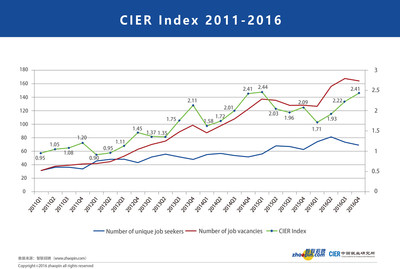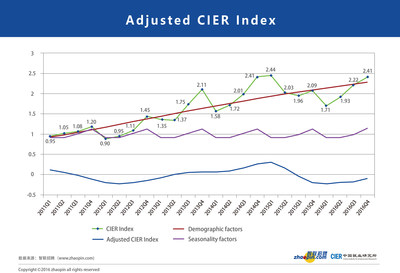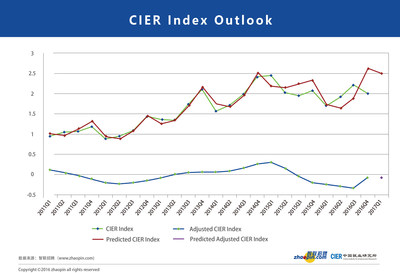|
20.01.2017 00:30:00
|
China Labor Market Keeping Upward Trend in the Fourth Quarter of 2016
BEIJING, Jan. 19, 2017 /PRNewswire/ -- Zhaopin Limited (NYSE: ZPIN) ("Zhaopin" or the "Company"), a leading career platform[1] in China focused on connecting users with relevant job opportunities throughout their career lifecycles, and the China Institute for Employment Research ("CIER") at Renmin University released the CIER Employment Index Report for the fourth quarter of 2016. The labor market in China maintained its upward trend as the CIER index reached its highest level since the first quarter of 2015, providing a favorable environment for job seekers.
Based on data from Zhaopin's online platform, the CIER index tracks the ratio changes between job vacancies and job seekers in a variety of industries and cities across the country, and identifies the overall trend in China's employment market. Jointly published by Zhaopin and the CIER at Renmin University, the CIER index has become a leading barometer of China's labor market and macro-economic environment.
The CIER index score is calculated by dividing the number of job vacancies during a specified period by the number of unique job seekers during the same period. A CIER index score of more than 1 indicates that the labor market is booming, with more vacancies than job seekers. A CIER index score of less than 1 indicates that the labor market competition is intensifying, with more job seekers than available vacancies.
China Fourth-Quarter 2016 Labor Market Highlights:
- The labor market in China kept its upward momentum in the fourth quarter of 2016 with the CIER index reaching 2.41, the highest since the first quarter of 2015, compared with 2.22 in the third quarter and 1.93 in the second quarter of 2016. This is an indication of bright prospects for those seeking new employment.
- Internet and e-commerce continued to be the best-performing sector and energy/mineral/mining/smelting remained the worst-performing sector.
- Except for Northeast China, the CIER index for all other regions improved in the fourth quarter from the third quarter of 2016.
- Micro-sized companies (companies with fewer than 20 employees) had the highest CIER index score of 2.10 in the fourth quarter of 2016, followed by 1.81 for large companies (companies with more than 10,000 employees).
- The CIER index is very likely to decline in the first quarter of 2017.
CIER Index Reaching All Year High in the Fourth Quarter of 2016
The job market in China had been on a declining trajectory in 2015 as the economic growth slowed down. With the overall economy improving in 2016, the job market reversed its declining trend and started to move upward since the second quarter of 2016. The momentum continued in the fourth quarter with the CIER index reaching 2.41, the highest level since the first quarter of 2015, compared with 2.22 in the third quarter and 1.93 in the second quarter of 2016.

Excluding the effects of seasonality and changing demographics, which have traditionally resulted in a long-term rise in the CIER index scores, the quarterly adjusted CIER index for the fourth quarter of 2016 showed a significant increase, indicating the continuing improvement in China's labor market.

According to Zhaopin's data, total online recruitment demand increased by 43% year-over-year in the fourth quarter of 2016, compared with a 35% year-over-year growth in the third quarter of 2016. As the economy improved, the labor market in China had gained momentum in the fourth quarter with increasing job demand year-over-year.
CIER Index by Sectors
With the economy continuing to undergo a shift from an industrial, manufacturing-based economy to one that is more service-based", the performance of different sectors continued to polarize in the fourth quarter of 2016. Internet and e-commerce was still the best-performing sector with a CIER index of 10.89, up from 7.28 in the third quarter. Insurance, funds/securities/futures/investment, traffic/transportation and intermediary service sectors were also performing well by CIER index rankings.
Ten best-performing sectors in the fourth quarter of 2016 | ||
Ranking | Sector | CIER index |
1 | Internet/e-commerce | 10.89 |
2 | Insurance | 5.69 |
3 | Funds/securities/futures/investment | 5.39 |
4 | Traffic/transportation | 5.08 |
5 | Intermediary service | 4.99 |
6 | Farming/forestry/animal husbandry/fishery | 4.67 |
7 | Computer software | 4.20 |
8 | Education/training/college | 3.38 |
9 | Media/publishing/film and television/culture dissemination | 3.33 |
10 | Real estate/construction/building materials/engineering | 3.30 |
The worst performing sectors by CIER index ranking in the fourth quarter of 2016 included energy/mineral/mining/smelting, printing/packaging/papermaking, and inspection/testing/authentication. These traditional industries were under great pressure from the economic restructuring. Still, a positive sign was that the CIER index for these industries did improve in the fourth quarter compared with the third quarter of 2016.
Ten worst-performing sectors in the fourth quarter of 2016 | ||
Ranking | Sector | CIER index |
1 | Energy/mineral/mining/smelting | 0.35 |
2 | Printing/packaging/papermaking | 0.38 |
3 | Inspection/testing/authentication | 0.40 |
4 | Environmental protection | 0.42 |
5 | Office supplies and equipment | 0.43 |
6 | Petroleum/petrochemical/chemical | 0.46 |
7 | Electricity/power/water conservancy | 0.54 |
8 | Instruments/apparatuses/industrial automation | 0.57 |
9 | Medical equipment/apparatus and instruments | 0.59 |
10 | Property management/business center | 0.60 |
IT and internetsector continued to generate huge job demand and to attract an influx of talents. In the fourth quarter of 2016, the job demand from this sector jumped by 48% year-over-year. Computer software posted the fast growth of 84% in job demand in the fourth quarter year-over-year. Most e-commerce companies had year-end promotions in the fourth quarter, which resulted in a 47% increase in job demand from internet/e-commerce companies.
Year-over-year change in recruitment demand for | |
IT/Internet | 48% |
IT service (system, data, maintenance) | 15% |
Internet/e-commerce | 47% |
Computer software | 84% |
Computer hardware | 19% |
Online games | 19% |
The real estate sector was still an important industry with increasing job demand in the fourth quarter of 2016, even though many cities had imposed purchase restrictions to curb the real estate bubble. The overall job demand in the sector went up 37% in the fourth quarter year-over-year.
Year-over-year change in recruitment demand for | |
Nationwide | 37% |
First-tier cities | 12% |
Emerging first-tier cities | 45% |
Second-tier cities | 55% |
Third-tier cities | 61% |
The financial sector saw recruitment demand increased by 19% in the fourth quarter of 2016 year-over-year, below the average growth rate of 43% nationwide.
Year-over-year change in recruitment demand for | |
Nationwide | 19% |
First-tier cities | 12% |
Emerging first-tier cities | 33% |
Second-tier cities | 21% |
Third-tier cities | 20% |
Traffic/transportation sector enjoyed the highest growth in job demand among all sectors with an 82% increase in the fourth quarter of 2016 year-over-year. The central and local governments had approved huge investments to improve the transportation infrastructure. The year-end promotions by e-commerce companies also created surging demand for courier services.
CIER Index by Regions and Cities
In the fourth quarter of 2016, Eastern China had the highest CIER index score of 2.07, followed by 1.94 for Central China and 1.77 for Western China. Except for Northeast China, the CIER index for all other regions improved in the fourth quarter over the third quarter of 2016. Among all regions, Central China saw the fastest increase in job demand at 73% in the fourth quarter year-over-year.
Northeast China was still the lowest with a CIER index score of 1.40 in the fourth quarter of 2016, the same as the third quarter. However, there were some positive signs as the government has introduced new initiatives to rejuvenate the economy in Northeast China. The job demand in the region increased by 59% in the fourth quarter year-over-year, higher than the 35% growth in the third quarter.
CIER index by regions | ||
Region | 4Q CIER | 3Q CIER |
Eastern China | 2.07 | 1.75 |
Central China | 1.94 | 1.69 |
Western China | 1.77 | 1.59 |
Northeast China | 1.40 | 1.40 |
With the development of the internet economy, emerging first-tier cities and lower-tier cities witnessed faster economic growth than first-tier cities, leading to more job demand in these cities and higher CIER index scores in the fourth quarter of 2016. The job market in the first-tier cities had become saturated with a CIER index of only 0.93 in the fourth quarter.
CIER index by cities | ||
City | 4Q CIER | 3Q CIER |
First-tier cities | 0.93 | 0.80 |
Emerging first-tier cities | 1.48 | 1.34 |
Second-tier cities | 2.23 | 1.63 |
Third-tier cities | 2.46 | 2.22 |
CIER Index by Size of Companies
Micro-sized companies (companies with fewer than 20 employees) had the highest CIER index score of 2.10 in the fourth quarter of 2016, followed by 1.81 for large companies (companies with more than 10,000 employees) and 1.18 for mid-sized companies (companies with 500 to 9,999 employees). Small-sized companies (companies with 20 to 499 employees) scored the lowest at 1.05.
CIER index by size of companies | ||
Company size | 4Q CIER | 3Q CIER |
Large-sized (more than 10,000 employees) | 1.81 | 1.42 |
Mid-sized (500 to 9,999 employees) | 1.18 | 1.01 |
Small-sized (20 to 499 employees) | 1.05 | 0.84 |
Micro-sized (fewer than 20 employees) | 2.10 | 3.11 |
The CIER index for micro-sized companies declined to 2.10 in the fourth quarter of 2016, down from 3.11 in the third quarter and 3.58 in the second quarter. Many of these micro-sized companies were still in the start-up stages and some had short lifecycles. However, such micro-sized companies were still the most dynamic companies in China. During the first three quarters of 2016, an average of 14,600 start-up companies were registered each day, which had created huge job demand in China.
Labor Market Outlook
The CIER index is very likely to decline in the first quarter of 2017 with seasonality factors, the long-term demographic trend and cyclical considerations.

About Zhaopin Limited
Zhaopin is a leading career platform in China, focusing on connecting users with relevant job opportunities throughout their career lifecycle. The Company's zhaopin.com website is the most popular career platform in China as measured by average daily unique visitors in each of the 12 months ended September 30, 2016, number of registered users as of September 30, 2016 and number of unique customers[2] for the three months ended September 30, 2016. The Company's over 125.2 million registered users include diverse and educated job seekers who are at various stages of their careers and are in demand by employers as a result of the general shortage of skilled and educated workers in China. In the fiscal year ended June 30, 2016, approximately 36.9 million job postings[3] were placed on Zhaopin's platform by 509,813 unique customers including multinational corporations, small and medium-sized enterprises and state-owned entities. The quality and quantity of Zhaopin's users and the resumes in the Company's database attract an increasing number of customers. This in turn leads to more users turning to Zhaopin as their primary recruitment and career- related services provider, creating strong network effects and significant entry barriers for potential competitors. For more information, please visit http://www.zhaopin.com.
Safe Harbor Statements
This press release contains forward-looking statements made under the "safe harbor" provisions of Section 21E of the Securities Exchange Act of 1934, as amended, and the U.S. Private Securities Litigation Reform Act of 1995. These forward-looking statements can be identified by terminology such as "will," "expects," "anticipates," "future," "intends," "plans," "believes," "estimates," "confident" and similar statements. Zhaopin may also make written or oral forward-looking statements in its reports filed with or furnished to the U.S. Securities and Exchange Commission, in its annual report to shareholders, in press releases and other written materials and in oral statements made by its officers, directors or employees to third parties. Any statements that are not historical facts, including statements about Zhaopin's beliefs and expectations, are forward-looking statements that involve factors, risks and uncertainties that could cause actual results to differ materially from those in the forward-looking statements. Such factors and risks include, but not limited to the following: Zhaopin's goals and strategies; its future business development, financial condition and results of operations; its ability to retain and grow its user and customer base for its online career platform; the growth of, and trends in, the markets for its services in China; the demand for and market acceptance of its brand and services; competition in its industry in China; its ability to maintain the network infrastructure necessary to operate its website and mobile applications; relevant government policies and regulations relating to the corporate structure, business and industry; and its ability to protect its users' information and adequately address privacy concerns. Further information regarding these and other risks, uncertainties or factors is included in the Company's filings with the U.S. Securities and Exchange Commission. All information provided in this press release is current as of the date of the press release, and Zhaopin does not undertake any obligation to update such information, except as required under applicable law.
[1] | Zhaopin's website is the most popular career platform in China as measured by average daily unique visitors in each of the 12 months ended September 30, 2016, the number of registered users as of September 30, 2016 and the number of unique customers for the three months ended September 30, 2016. |
[2] | A "unique customer" refers to a customer that purchases the Company's online recruitment services during a specified period. Zhaopin makes adjustments for multiple purchases by the same customer to avoid double counting. Each customer is assigned a unique identification number in the Company's information management system. Affiliates and branches of a given customer may, under certain circumstances, be counted as separate unique customers. |
[3] | Zhaopin calculates the number of job postings by counting the number of newly placed job postings during each respective period. Job postings that were placed prior to a specified period - even if available during such period - are not counted as job postings for such period. Any particular job posting placed on the Company's website may include more than one job opening or position. |
For more information, please contact:
Zhaopin Limited
Ms. Daisy Wang
Investor Relations
ir@zhaopin.com.cn
ICR Beijing
Mr. Edmond Lococo
Phone: +86 10 6583-7510
Edmond.Lococo@icrinc.com
To view the original version on PR Newswire, visit:http://www.prnewswire.com/news-releases/china-labor-market-keeping-upward-trend-in-the-fourth-quarter-of-2016-300393606.html
SOURCE Zhaopin Limited
 Der finanzen.at Ratgeber für Aktien!
Der finanzen.at Ratgeber für Aktien!
Wenn Sie mehr über das Thema Aktien erfahren wollen, finden Sie in unserem Ratgeber viele interessante Artikel dazu!
Jetzt informieren!
Nachrichten zu Zhaopin Ltd (A) (spons. ADRs)mehr Nachrichten
| Keine Nachrichten verfügbar. |